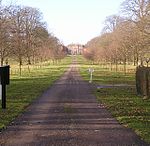Kerne Bridge (River Wye crossing)
Bridges across the River WyeBridges completed in the 1820sBridges in HerefordshireIncomplete lists from October 2020

Kerne Bridge was built over the River Wye in the County of Herefordshire, England in 1825–28, on the site of an ancient ford crossing known as Flanesford. It is designated as a Scheduled Monument. Carrying the B4229 road, it connects the parishes of Walford on the river's left bank and Goodrich on the right. It is situated in the heart of the Wye Valley Area of Outstanding Natural Beauty and marks the northern end of the Upper Wye Gorge.
Excerpt from the Wikipedia article Kerne Bridge (River Wye crossing) (License: CC BY-SA 3.0, Authors, Images).Kerne Bridge (River Wye crossing)
B4234,
Geographical coordinates (GPS) Address Nearby Places Show on map
Geographical coordinates (GPS)
| Latitude | Longitude |
|---|---|
| N 51.868 ° | E -2.60849 ° |
Address
B4234
HR9 5QT
England, United Kingdom
Open on Google Maps







